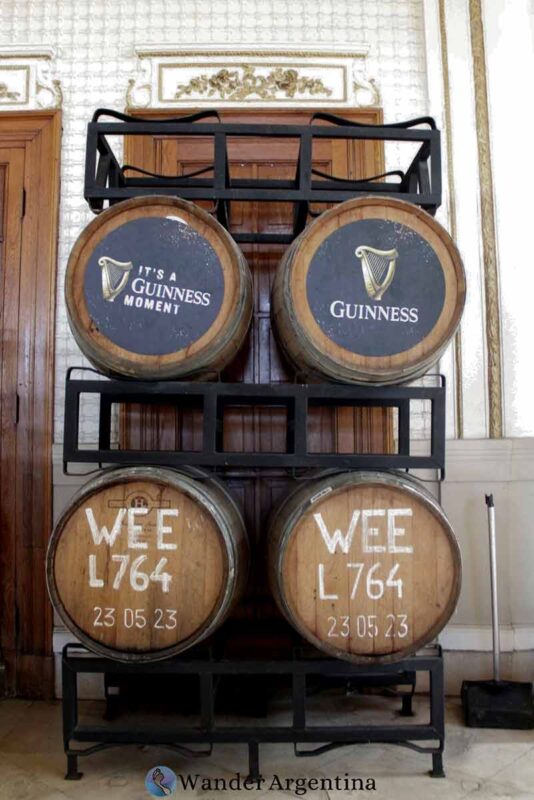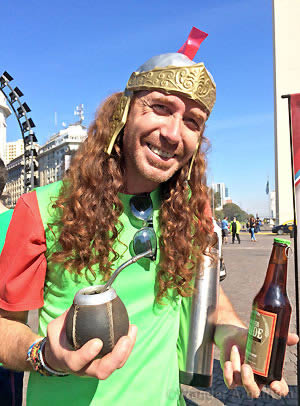“The first thing to note is that in my son’s veins flowed the blood of the Irish rebels.”
—Ernesto Guevara Lynch, speaking of his son, Ernesto ‘Che’ Guevara.
Everyone knows the iconic image of Argentina’s Che Guevara, but few know that the revolutionary was of Irish heritage, along with roughly a half a million Irish descendants throughout the country today.
Argentina is home to South America’s largest Irish community and the world’s fifth largest among the Irish diaspora.
The true number of Irish descendants is unknown due to poor record-keeping during the early immigration wave.

The fact that the Irish were counted as English in official records until 1920 only further confuses things.
When the Irish first arrived in Argentina they retained a strong cultural identity. In towns such as Duggan, San Antonio de Giles, and San Antonio de Areco they built churches with English confessions available and gathered for ‘ceilidh’ to play traditional Irish music.
After several generations, the Irish became more integrated with Argentines.
Many average citizens lost touch with their Irish roots, but in recent years there has been a surge of interest in Irish culture.
For visitors, this can be most noticeably witnessed on Saint Patrick’s Day and among the young people in Irish pubs of the Retiro neighborhood of Buenos Aires, where the beer and Irish whiskey flows and U2 cover bands play late into the night.
Irish Immigration to Argentina
Beginning even before the Great Potato Famine of 1845, the Irish looking to escape hunger and English oppression faced the choice to emigrate to the United States, Canada or Argentina.
Passage to Canada and the United States was free for Irish immigrants, while many had to pay for their passage to Argentina.
In Argentina’s favor was that it is a predominately Catholic country, while Catholics were discriminated against in North America.
But Irish immigrants to Argentina had to contend with a new language and culture.
Argentina courted Irish immigrants because of their reputations as hard workers with experience in agriculture and sheep herding.
The Irish, dreaming of life on the Argentine Pampa, were looking to escape famine and religious persecution.
Argentina was a good option as a wealthy Catholic country, with plenty of available land.
In the late 19th century, Irish immigrants founded the Hurling Club, playing their first tournaments of the hockey-like sport in what is now Plaza Irlanda in Buenos Aires’ Caballito neighborhood.
When it became impossible to import Hurling sticks during World War I, many moved over to hockey and rugby.
Currently, an effort is underway to revive hurling in Buenos Aires.
Irish Educational Legacy
Wherever there are Irish there are bound to be priests and nuns, and they founded some of Buenos Aires’ most established schools.
Among the schools still existing today in and around Buenos Aires are Fahy, Colegio Irlandés (Irish High School), Limerick Bilingual, San Brendan and Santa Brígida High Schools.
The tomb of Father Anthony Dominic Fahy, a leader in the Irish community in the mid-19th century, ranks among the prominent tombs in Buenos Aires’ famed Recoleta cemetery.
The Southern Cross, a Buenos Aires-based newspaper originally published in English, Spanish and Gaelic and founded in 1875, is still being published today.
The Dresden Affair: An Immigrant Tragedy
While thousands of immigrants from all over Europe were arriving to the ports of Buenos Aires by 1889, Archbishop of Cashel, T.W. Croke warned his countrymen that the prospects in Argentina were not favorable.
He wrote in a Dublin newspaper:
“Buenos Aires is a most cosmopolitan city into which the Revolution of (18)48 has brought the scum of European scoundrelism.
I most solemnly conjure my poorer countrymen, as they value their happiness hereafter, never to set foot on the Argentine Republic however tempted to do so they may be by offers of a passage or an assurance of comfortable homes.”
So as with every Irish story, there is tragedy woven within the rather complex story of Irish-Argentine history.
In this case, it’s the 1889 ‘Dresden Affair’ which occurred about a month later.
Some 2000 poor Irish, mostly from the counties of Dublin and Cork, were shipped in terrible conditions to Argentina — many didn’t make the 19-day voyage.
Once they arrived, the country was ill-equipped to handle the remaining passengers, especially because the once-profitable sheep industry was in decline.
At first, the immigrants were on the streets. Some stayed in stables in Buenos Aires’ Retiro neighborhood. They had no food or water and their luggage, which had been sent ahead, was lost.
Children who had been separated from — or lost — their parents were left to fend for themselves and lone girls were forced into prostitution in the portside red-light district of Buenos Aires.
Some 800 of the immigrants were sent to the area of Bahia Blanca to set up the Irish Colony of Napostá, but they discovered that the coastal area is one of the few regions of the country that is unfavorable to agriculture.
After such a terrible journey and rough start in Argentina, within a year, those who could go back to Ireland or emigrated to other countries. To this day the fates of many of the 1772 people who were on the SS Dresden are unknown.
The Dresden Affair effectively ended Irish immigration to Argentina.
Saint Patrick’s Cathedral Massacre
Irish Argentines did not escape the brutality of Argentina’s last dictatorship either.
In fact, some Irish Argentines were among their first victims in an incident known as the Saint Patrick’s Massacre.
In the early morning on July 4, 1976, only months after the military dictatorship gained power, parishioners arrived for mass at Saint Patrick’s Church in Buenos Aires’ tony Belgrano neighborhood.
Congregants found the doors of the church closed and grew concerned when mass was supposed to be beginning.
An organist climbed through a window. Once inside he discovered a horrific scene: the dead bodies of three Pallottine priests, Alfredo Leaden, Alfredo Kelly, Peter Duffau, and two seminarians Salvador Barbeito and Emilio Barletti.
Around the crime scene were messages and cartoons that made it clear they were killed for their ideological beliefs.
In 1984 the National Commission on the Disappearance of Persons determined the murders were carried out by the Argentine Navy.
While he was still Archbishop, Jorge Mario Cardinal Bergoglio, later Pope Francis, opened the cause in Argentina for beatification—the first step towards sainthood—for the five victims.
Kelly was a spiritual advisor to Bergoglio as a young man.
Once he was chosen as Pope, Francis approved the request for sainthood for the Pallottines.
Lasting Influence of the Irish on Argentina
Irish immigration had a lasting effect on Argentine culture, even though immigration dropped off after the Dresden Affair.
The ‘Latins of Northern Europe’ share with Argentine traits of friendliness, passionate self-expression, sometimes hot tempers and love of spirits, music and gatherings.
Irish-Argentine, Alejandro Perry, a student of Irish Step Dance at the Fahy Club in Belgrano has a typical story of a renewed interest in Celtic culture among Irish descendants here.
“When I turned 40 I began to have an interest in my Irish roots. I started to read about the Druids, Irish mythology and history,” he says.
“The culture interests me because of the music, the dance, the love of poetry, the values and respect for nature.
It all coincided with a spiritual journey — I began to discover who I am and why I am the way I am.”
Perry, like many Irish-Argentines, has a family story that stretches between Ireland, the United States and Argentina.
His grandfather was born in the United States to Irish parents but came to Argentina in the early 19th century.
“My grandfather became a professor at the University of La Plata and married the university director’s daughter. He was able to establish a good life here.”
Celtic Roots at the Fahy Club
When Perry first walked into the Fahy Club he says,
“I felt right at home. Even the style of the house and the garden remind me of my grandfather’s house. I feel comfortable there. My biggest dream is to go to Ireland one day.”
Ireland’s economic growth in recent decades and the 90s popularity of Irish groups such as U2, The Cranberries and the Chieftains also played a part in the increased interest in Irish culture in Argentina.

“I think the Irish are open-minded and creative.
“The best example of this is how they built up their economy in the ’90s while a lot of other countries like Argentina were going down the tubes,” says Perry.
“They used creativity to develop the country economically without sacrificing their culture, something that, with globalization, a lot of other countries have not been able to do.”
Guinness Back in Argentina
Although there are Irish in Argentina, one thing that was missing for years was Guinness stout.

Important restrictions made Ireland’s favorite beer impossible to get, so bars had to make do with other stouts.
In 2021, Guinness announced that they had partnered with a local brand to produce the creamy Irish stout in Argentina.
It’s the first time it’s been produced in all of South America.
Now visitors can properly toast the Irish in Argentina.
Books on the Irish in Argentina
‘Irish Ingleses’: The Irish Immigrant Experience in Argentina 1840-1920
by Helen Kelly
A historical analysis of the Irish experience in Argentina. Important historical figures and how they ended up helping to shape the church, education, sport and other fundamentals of Argentina’s civic life.
Paisanos: The Forgotten Irish who changed the Face of Latin America
by Tim Fanning
It wasn’t just the history of Argentina that the Irish helped shape in Latin America.
Discover the Irish liberators who fought for the sovereignty of Latin America.
→ Click here to read about St. Patrick’s Day Celebrations in Buenos Aires
Famous Irish-Argentines
| Admiral William ‘Guillermo’ Brown | War hero and founder of the Argentine Navy has 1,200 streets named after him in Argentina |
General Edelmiro Julián Ferrel | Former president, preceding Juan Domingo Perón |
| Maria Elena Walsh | Prolific writer and musician particularly loved for her children’s books |
| Roldofo Walsh | Writer and founder of investigative journalism in Argentina, disappeared during the Dirty War |
| Valeria Lynch | Pop singer popular in the 1980s |
| Norma Nolan | Winner of the 1962 Miss Universe Pageant |
| Father Anthony Fahy | Leader of the Irish community in the mid-19th century |







